Samsung was first to the enterprise 2.5" NVMe SSD party when they announced the XS1715 in the summer of 2013. It was also the first solid-state drive to leverage the new SFF-8639 connector. While the drive didn't enter mass production until September of 2014, the XS1715 found immediate adoption by server OEMS looking to push the boundaries of what was possible in terms of high-speed server storage. We first saw the XS1715 in the Dell PowerEdge R920, which is part of Dell's 4x CPU powerhouse server line. Dell supported up to eight of the NVMe drives in that system and even with just two 800GB XS1715s, we saw over 1.1 million 4K read IOPS and over 800,000 8K read IOPS; it is also quoted to deliver sequential read speeds up 3,000MB/s, allowing it to process 500GB of data in under 3 minutes. As such, we will somewhat belatedly take a look at the 1.6TB XS1715 SSD to see how it holds up with a little bit of age on it, as the rest of the industry races to shake Samsung from its early leadership position in enterprise NVMe market.
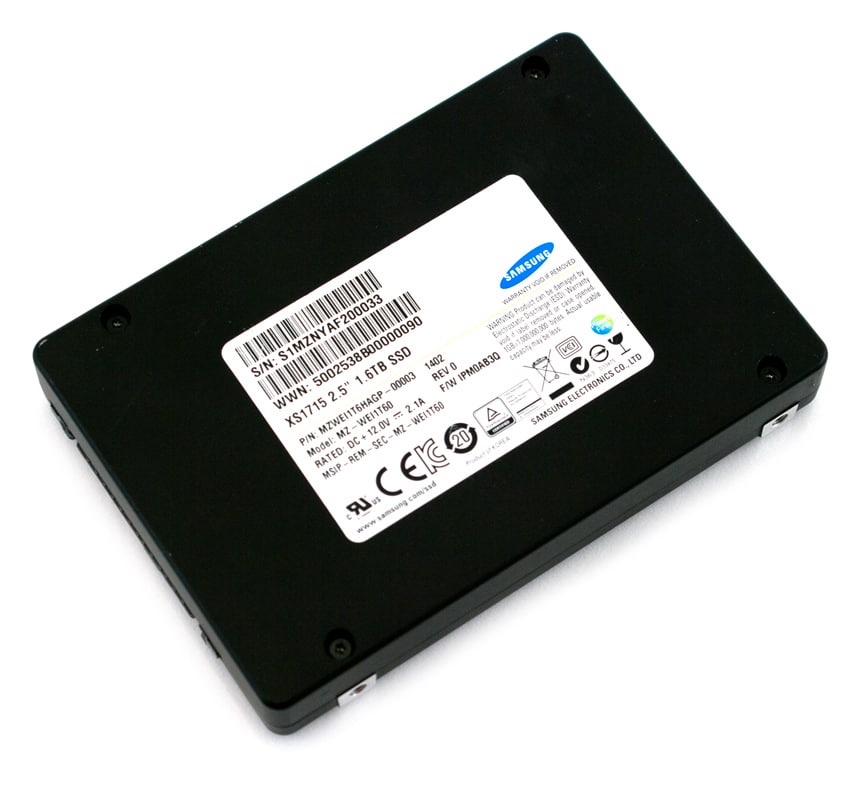
There have been several NVMe drives to hit the market since then, such as the Memblaze PBlaze4 and Intel SSD DC P3700 drives, both of which we will be comparing the XS1715 to in our performance section of the review.
At the heart of the XS1715 is the PMC 89HF16P04CG3 controller, which is a high performance PCIe Flash controller optimized for enterprise workloads. The controller is also comprised of a programmable architecture, allowing SSD developers to control product differentiation through firmware customization. This is something that Samsung certainly has leveraged. The XS1715 is also equipped with full data path protection and power loss protection through its tantalum capacitors, the XS1715 offers an Uncorrectable Bit Error Rate (or UBER) rating of 1 in 1017. The XS1715 also features an impressive two million hour MTBF. The XS1715 NVMe SSD comes in capacities of 400GB, 800GB and 1.6TB, the former, which we will be testing. Additionally, the Samsung drive is a part of the NVMe Integrators List (IL), meaning that the XS1715 is an easy-to-manage drive and a highly reliable solution for both data center and server/storage customers.
The XS1715 SSD comes with a five year warranty and is backed by the 5-year DWPD guarantee.
Samsung XS1715 Specifications
- Form Factor 2.5”: (SFF-8639)
- Capacity (GB): 400GB, 800GB, 1.6TB
- Host Interface: PCIe Gen 3.0 (x4) — NVMe
- Physical Dimensions: 100 x 70 x 15mm
- Weight: 210g
- MTBF: 2,000,000 hours
- Uncorrectable Bit Error Rate (UBER): 1 in 1017
- Power Consumption (Active/Idle): 25/8 W
- Sustained Performance
- Read Latency: 90 μs
- Write Latency: 25 μs
- 4K Random Reads: Up to 750,000 IOPS
- 4K Random Writes: Up to 115,000 IOPS
- 128K Sequential Reads: Up to 3,000 MB/s
- 128K Sequential Writes: Up to 1,400 MB/s
- Endurance 4K Random WPD:
- 400GB: 7 WPD
- 800GB/1.6TB: 5.6 WPD
Design and Build
Available in a 2.5" form factor via a 15mm z-height, the XS1715 interfaces with the PCIe bus using the SFF-8639 connector. Though this looks similar to a typical SAS connector, it is not. The look and feel of the XS1715 is in line with rest of Samsung’s SSD portfolio, sporting a minimalistic, matte-black design with just the company’s branding and drive type.
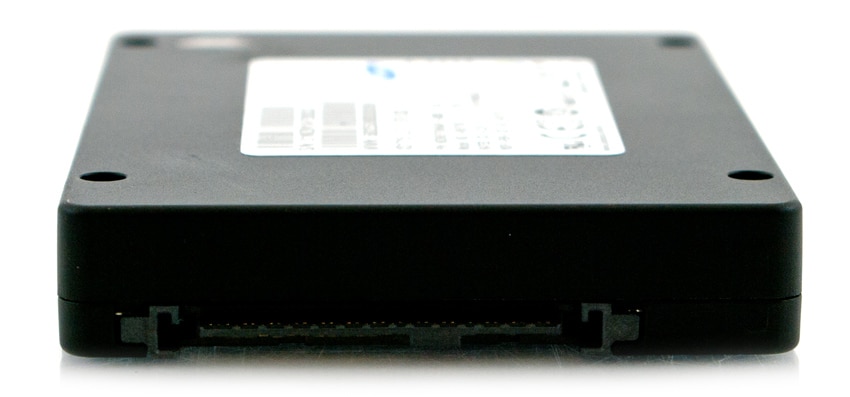
The side profiles of the drives have 4 holes for easy mounting inside a workstation or server. Inside the drive has a dual PCB build as well as a large thermal pad to help keep the components dissipate heat under load.
Testing Background and Comparables
The StorageReview Enterprise Test Lab provides a flexible architecture for conducting benchmarks of enterprise storage devices in an environment comparable to what administrators encounter in real deployments. The Enterprise Test Lab incorporates a variety of servers, networking, power conditioning, and other network infrastructure that allows our staff to establish real-world conditions to accurately gauge performance during our reviews.
We incorporate these details about the lab environment and protocols into reviews so that IT professionals and those responsible for storage acquisition can understand the conditions under which we have achieved the following results. None of our reviews are paid for or overseen by the manufacturer of equipment we are testing. Additional details about the StorageReview Enterprise Test Lab and an overview of its networking capabilities are available on those respective pages.
We tested the 2.5" Samsung XS1715 inside the Supermicro SuperServer 2028U-TNR4T 4x NVMe system, while comparing it to the NVMe SSDs:
- 2.5" Intel SSD DC P3700 SSD
- 2.5" Memblaze PBlaze4 SSD
Application Workload Analysis
In order to understand the performance characteristics of enterprise storage devices, it is essential to model the infrastructure and the application workloads found in live production environments. Our first benchmarks for the Samsung XS1715 are therefore the MySQL OLTP performance via SysBench and Microsoft SQL Server OLTP performance with a simulated TCP-C workload. For our application workloads each drive will be running 2-4 identically configured VMs.
StorageReview’s Microsoft SQL Server OLTP testing protocol employs the current draft of the Transaction Processing Performance Council’s Benchmark C (TPC-C), an online transaction processing benchmark that simulates the activities found in complex application environments. The TPC-C benchmark comes closer than synthetic performance benchmarks to gauging the performance strengths and bottlenecks of storage infrastructure in database environments. Each instance of our SQL Server VM for this review uses a 333GB (1,500 scale) SQL Server database and measures the transactional performance and latency under a load of 15,000 virtual users.
When looking at SQL Server Output, the Intel drive had the highest aggregate throughput with 3,157.341 TPS and the highest throughput of an individual VM with 3,157.469, though the XS1715 had an individual VM that was within less than 0.1 in TPS of the Intel VM.
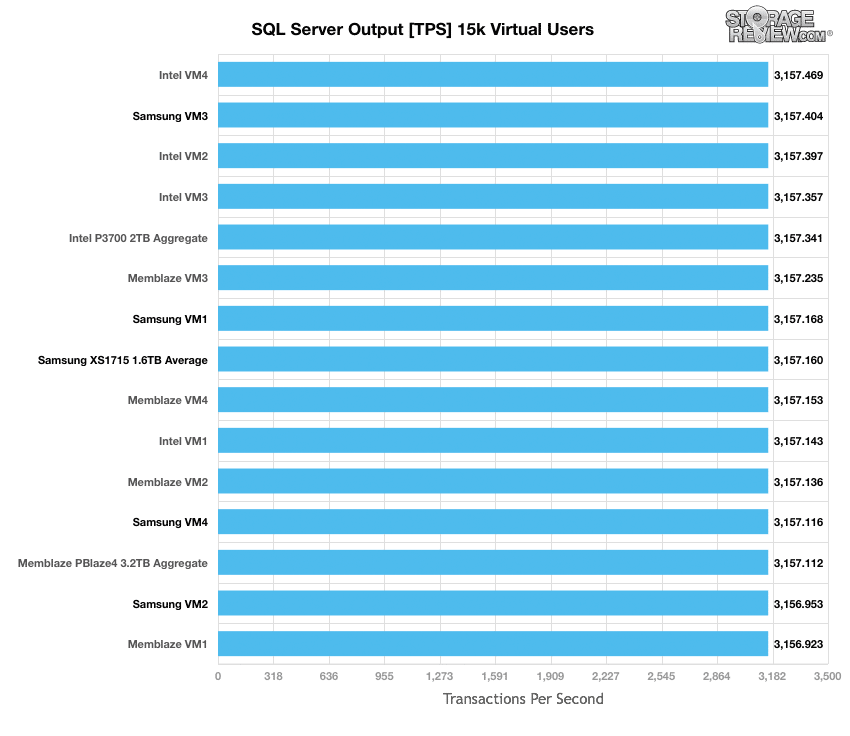
The average latency results during the 15k user SQL Server benchmark placed the Samsung drive at the front of the pack, all which had a latency of 7ms making the average 7ms as well. Results were identical with the Intel P3700 SSD while the Memblaze drive had a slightly higher aggregate with 7.5ms.
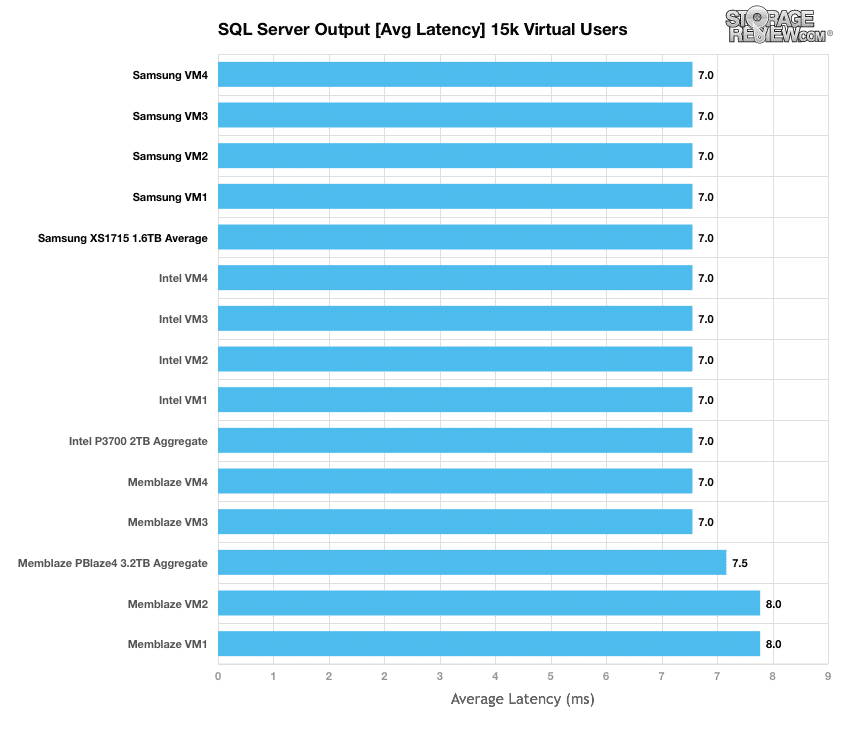
The next application benchmark consists of a Percona MySQL OLTP database measured via SysBench. This test measures average TPS (Transactions Per Second), average latency, as well as average 99th percentile latency. Percona and MariaDB are using the Fusion-io flash-aware application APIs in the most recent releases of their databases, although for the purposes of this comparison we test each device in their "legacy" block-storage modes.
In the average transactions per second benchmark, the XS1715 placed well below the top of the pack, recording a performance of 3,463.6 TPS. The Intel drive showed the best performance, with an aggregate of 5,779.7 TPS.
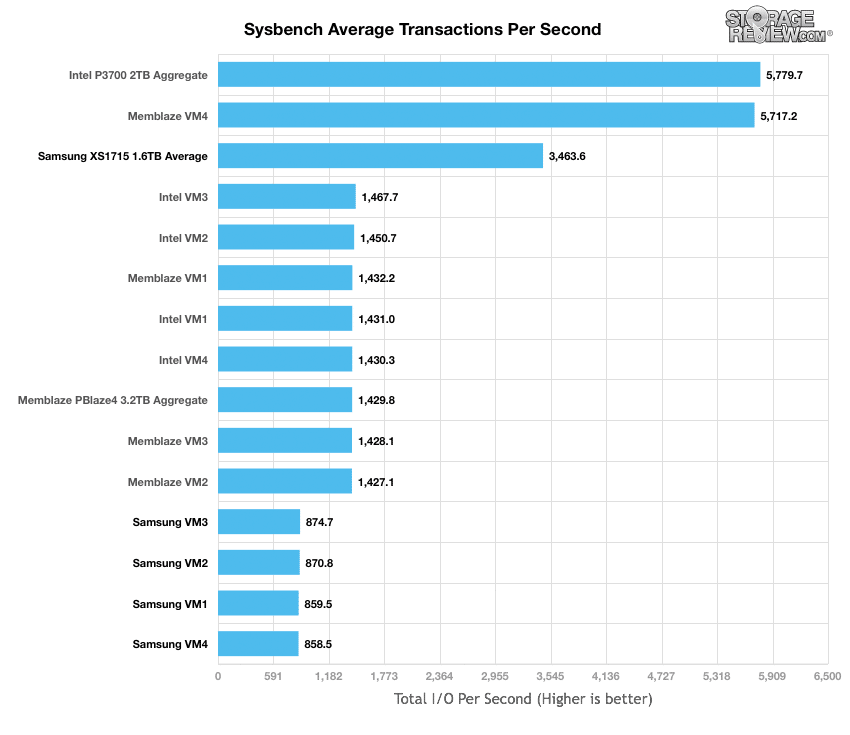
Average latency results show generally the same placement of the drives with Samsung at the bottom once again with individual VMs running between 37.27ms through 36.58ms and average latency of 36.96ms. The Intel drives were at the top again, with 21.80ms. Intel also had the best aggregate score at 22.15ms.
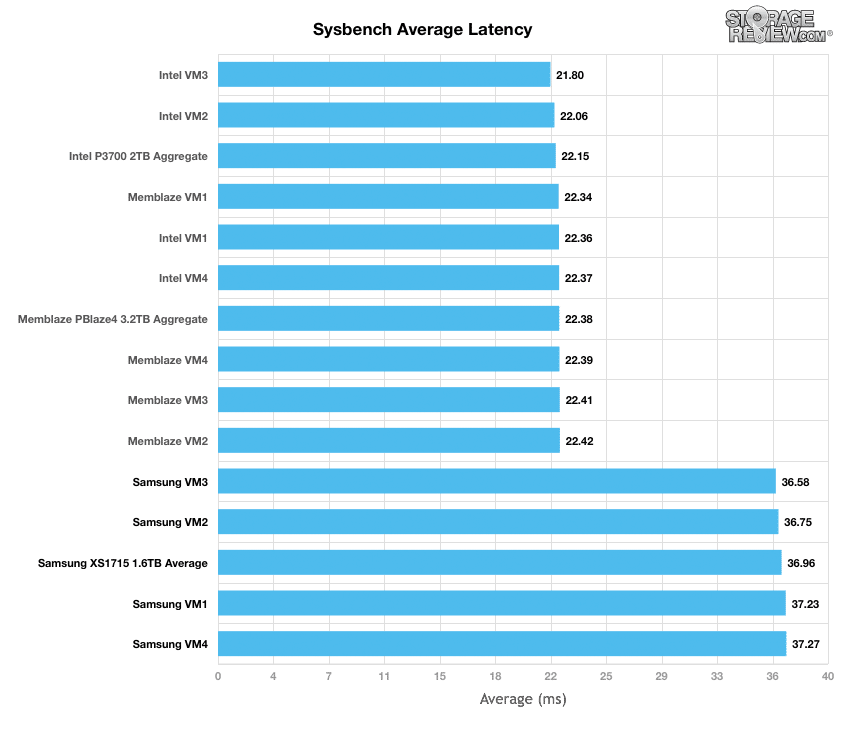
In terms of our worst-case MySQL latency scenario (99th percentile latency), the Samsung XS1715 placed at the bottom of the leaderboard by a noticeable margin, with VMs running between 71.97ms and 73.36ms and an average score of 73.03ms.
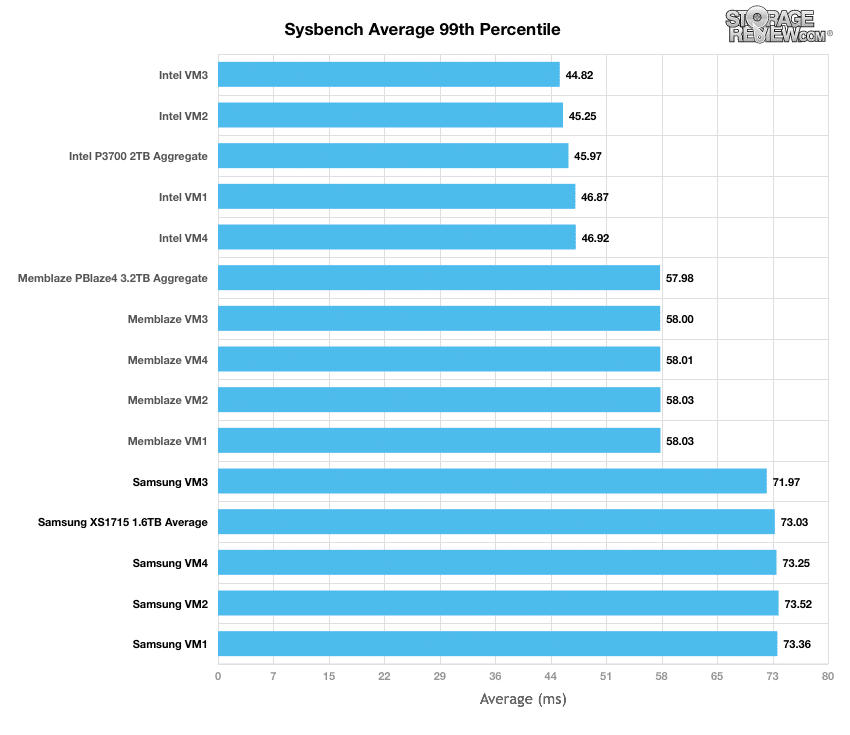
Enterprise Synthetic Workload Analysis
Flash performance varies as the drive becomes conditioned to its workload, meaning that flash storage must be preconditioned before each of the fio synthetic benchmarks in order to ensure that the benchmarks are accurate. Each of the comparable drives are preconditioned into steady-state with a heavy load of 16 threads and an outstanding queue of 16 per thread.
Preconditioning and Primary Steady-State Tests:
- Throughput (Read+Write IOPS Aggregate)
- Average Latency (Read+Write Latency Averaged Together)
- Max Latency (Peak Read or Write Latency)
- Latency Standard Deviation (Read+Write Standard Deviation Averaged Together)
Once preconditioning is complete, each device is then tested in intervals across multiple thread/queue depth profiles to show performance under light and heavy usage. Our synthetic workload analysis for the Samsung XS1715 uses two profiles, which are widely used in manufacturer specifications and benchmarks. It is important to take into consideration that synthetic workloads will never 100% represent the activity seen in production workloads, and in some ways inaccurately portray a drive in scenarios that wouldn't occur in the real world.
- 4k
- 100% Read and 100% Write
- 8k
- 70% Read/30% Write
In our throughput 4k write preconditioning test, the Intel P3700 was the top performer, starting around 400,000 IOPS before hitting a steady-state just under 170,000 IOPS. Though the Samsung XS1715 showed burst results the place it just behind the Intel drive, it fell to last place (behind the much more consistent Memblaze) in its stead-state of roughly 113,000 IOPS.
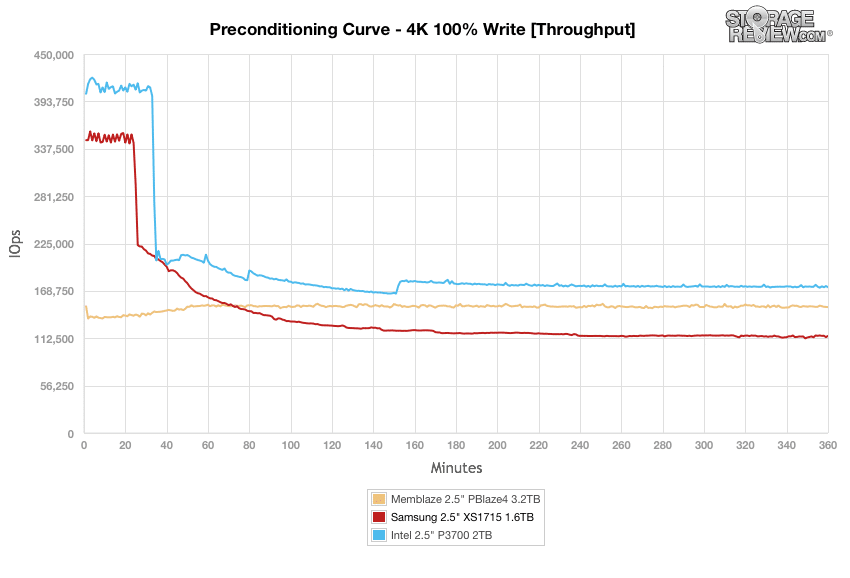
In average latency, both the Samsung and Intel drives started around the 0.6ms mark while spiking sometime after 20 minutes. The Intel drive remained the most stable for the remainder of the test, taking top spot; however, the Memblaze was the most consistent drive latency-wise.
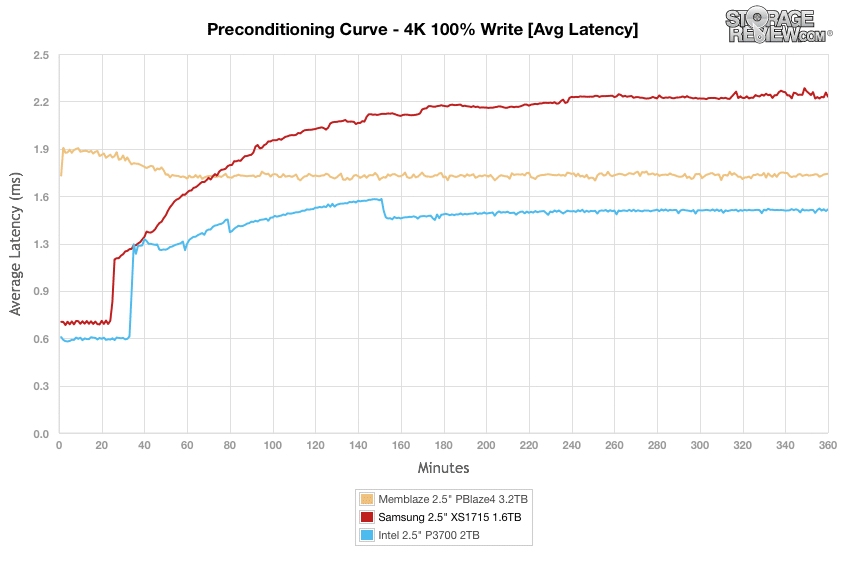
Results were relatively the same when looking at max latency, as the Memblaze remained the most consistent drive. The Samsung XS1715 showed excellent latency at the beginning of the test, though it soon tapered off and ending with a steady-state of roughly 2.2ms.
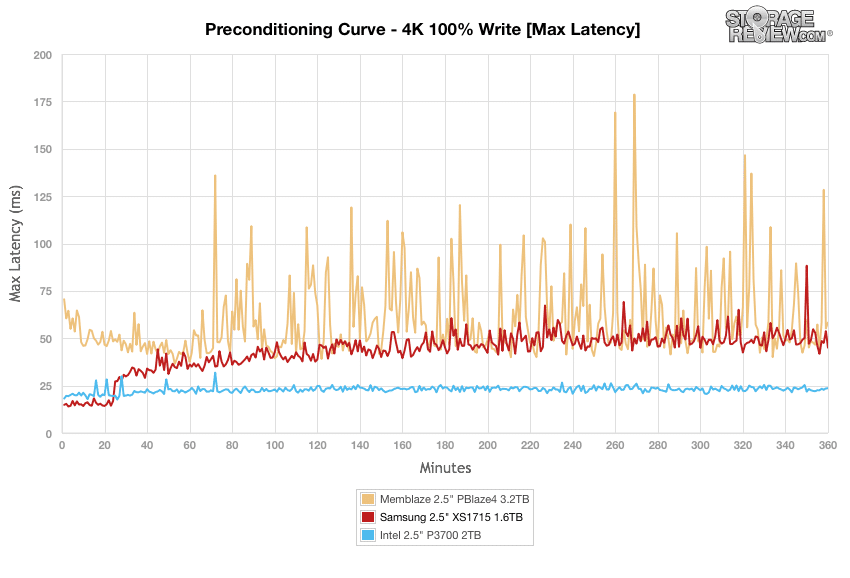
Standard deviation calculations is designed make it easier visualize the consistency of the SSD latency performance results. Here, the Samsung drive started out strong, though it took a significant spike in latency around the 22 minute mark and ending up hovering around the 3.0ms mark by the end.
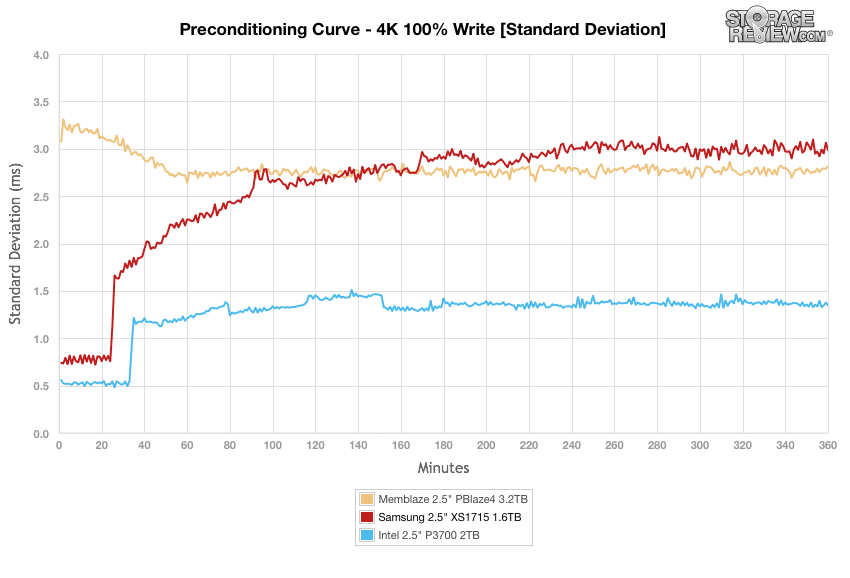
During the primary 4k synthetic benchmark, the Samsung XS1715 placed at the bottom of our throughput with 420,544 IOPS read and 114,444 IOPS write. The Memblaze was by in far the top performer in the read column with a blistering 717,172 IOPS while the Intel drive showed the best write performance with 172,672 IOPS.
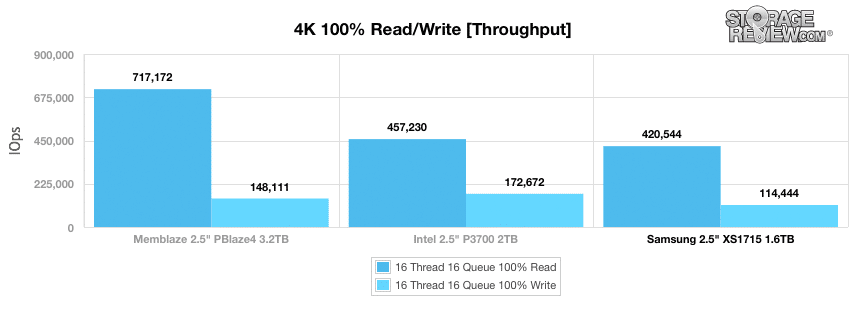
Results were mirrored with average latency, as the Samsung drive showed 0.61ms read and 2.23ms write, which placed last (though not by much).
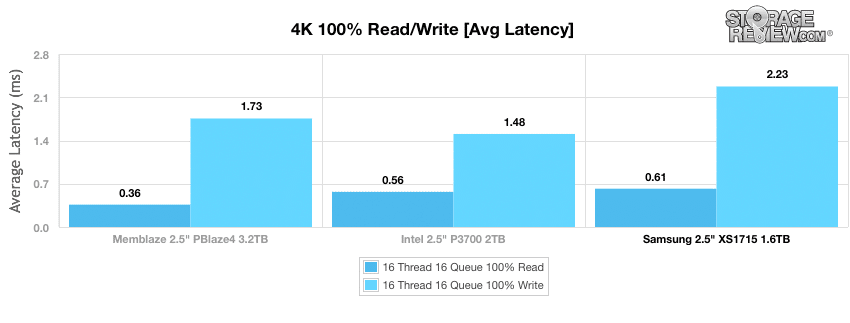
In max latency, the Samsung XS1715 boasted the lowest max latency in reads with just 5.8ms. The best drive in max write latency was the Intel P3700, which recorded 33.1ms.
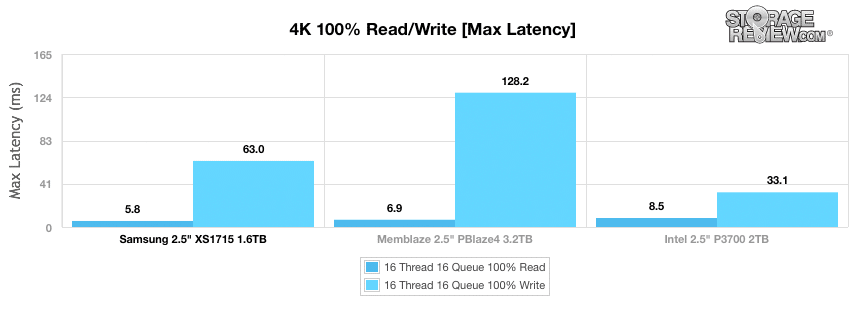
In standard deviation, the Samsung XS1715 showed the top read latency again with 0.08ms (with 2.994ms write). The best drive in write latency consistency was the Intel drive with 1.377ms.
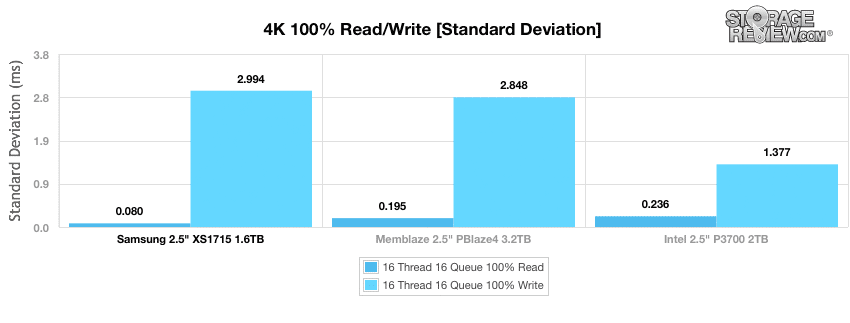
Our next workload uses 8k transfers with a ratio of 70% read operations and 30% write operations. Again, we will start off with the preconditioning results before switching to the main tests. In throughput, the Samsung drive showed a series of spikes at beginning of the test trailing both the Intel and Memblaze drives during its entirety, ending up with roughly 120,000 IOPS.
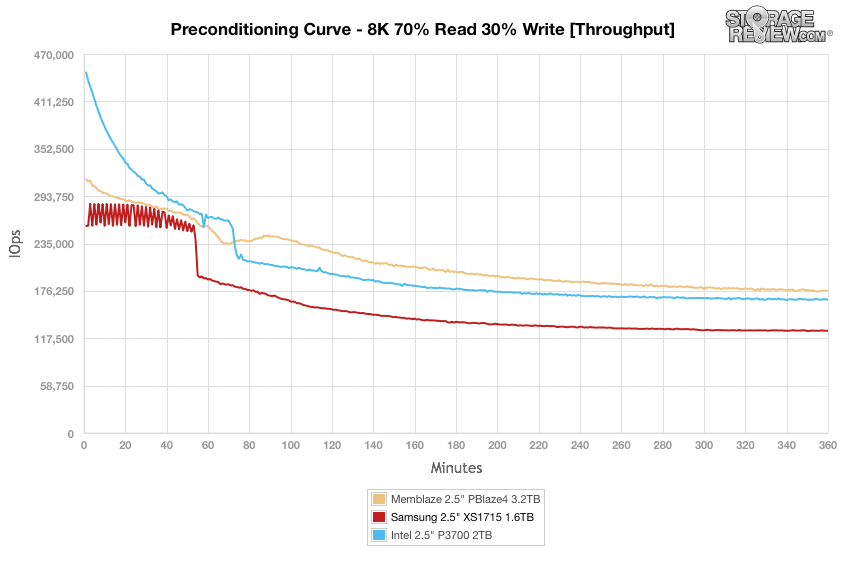
Average latency had similar results, with the Samsung drive showing various spikes at the first portion of the test. By the end, it reached a steady-state around 2.0ms.
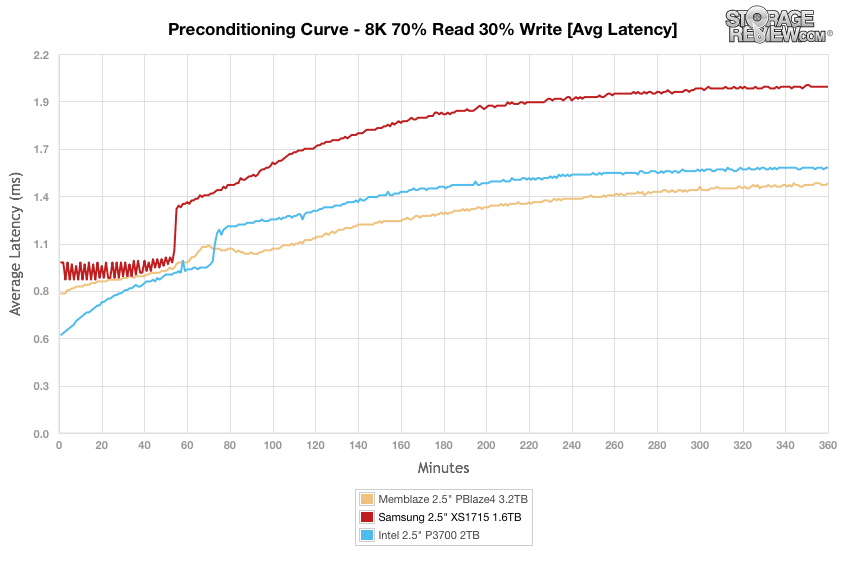
When looking at max latency, the most consistent drive was by far the Intel drive, showing a somewhat steady-state throughout. The Samsung drive recorded minor spikes during the test; however, the Memblaze SSD had very inconsistent latency, posting huge spikes during the entire benchmark.
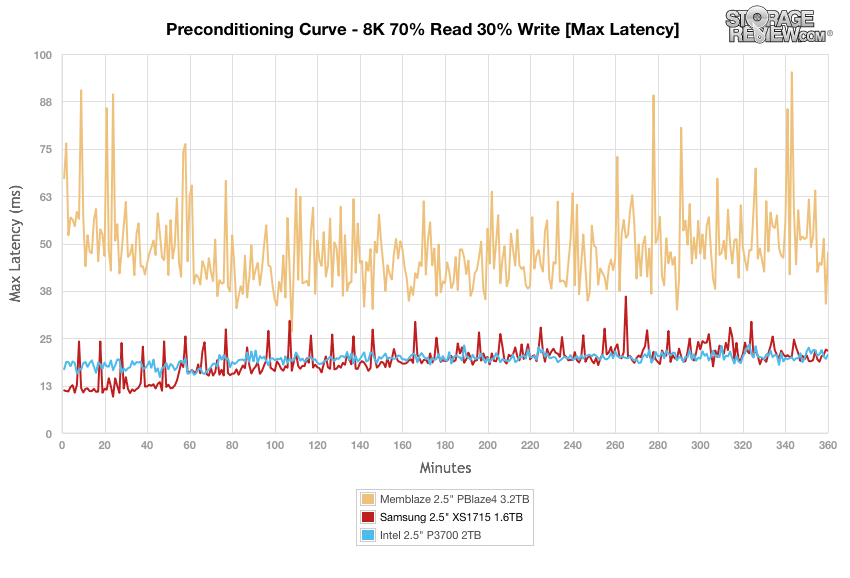
Standard deviation showed unstable latency during the first hour of the test for the Samsung drive, and ended up with roughly 1.4ms by the end of the benchmark, which placed it slightly better than the Memblaze. The Intel P3700 showed the best results, as it only peaked over the 1.2ms on several occasions.
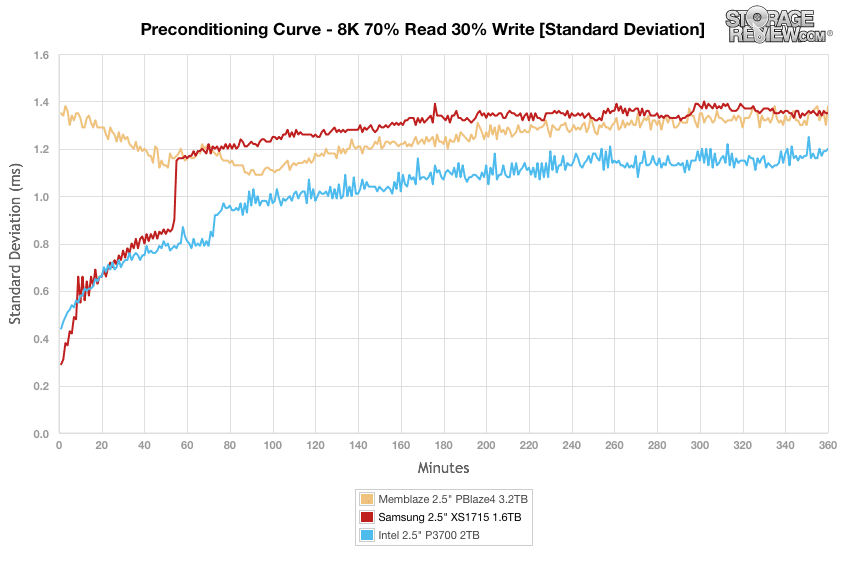
After we fully preconditioned the Samsung drive, we put it through our main 8k 70/30 test. In throughput, the Samsung drive trailed both the Intel and Memblaze drives throughout the test until the end, starting at roughly 23,700 IOPS and ending up with around 128,000 IOPS.
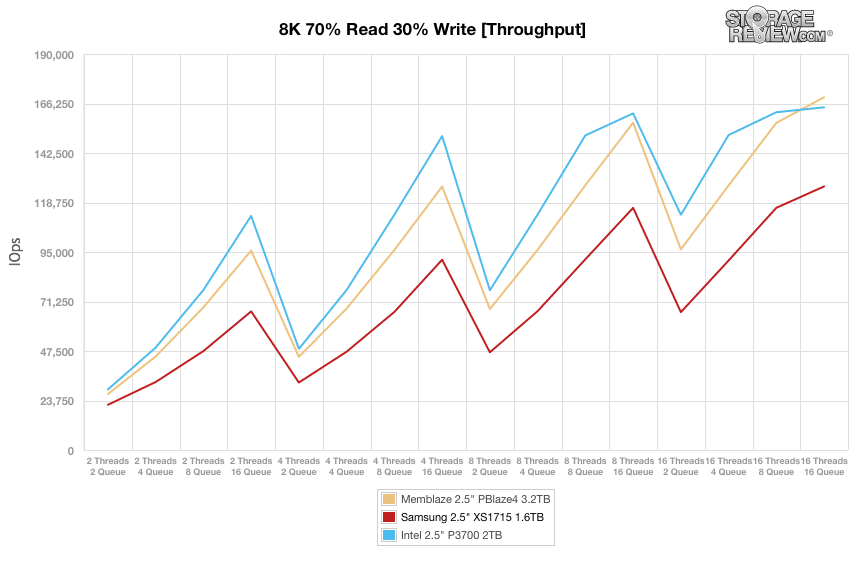
Average latency told a similar story, though the results of the Intel and Memblaze drives were much closer. The Samsung drive started at roughly 0.2ms with up almost 2.0ms by 16T/16Q. The other two drives a bit better than the Samsung, with both ending up with a latency of 1.6ms in the terminal.
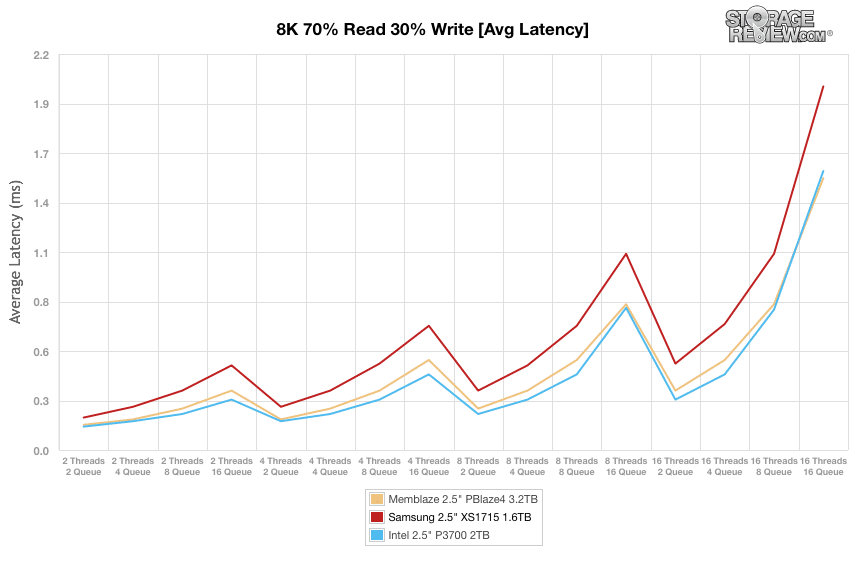
Looking at max latency showed that the Samsung XS1715 had the most consistent results with the least amount of latency spiked; however, the Intel P3700 had the best overall results, as it only passed the 20ms mark on a few occasions.
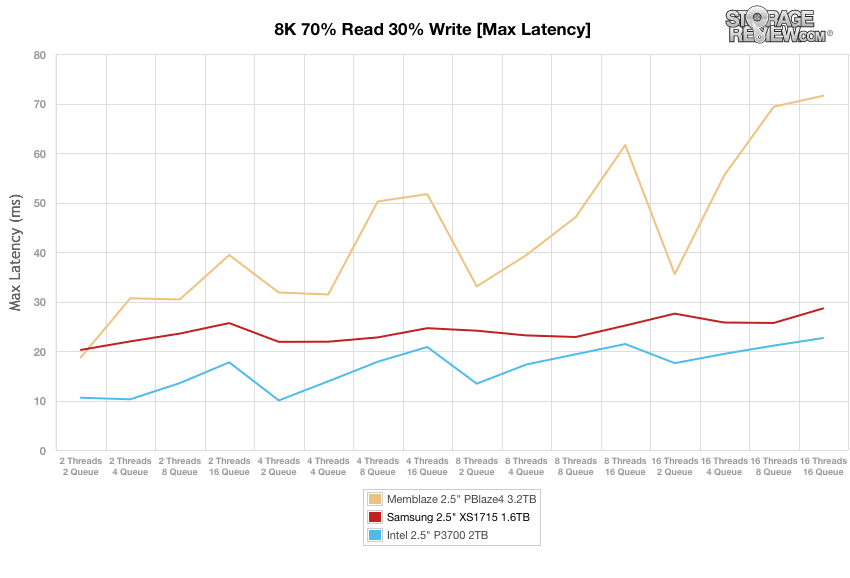
Standard deviation showed similar results to that of average latency, though the Samsung XS1715 edged out the Memblaze drive at the terminal queue depths. The Intel drive boasted the best overall results with a range of 0.2ms to 1.15ms.
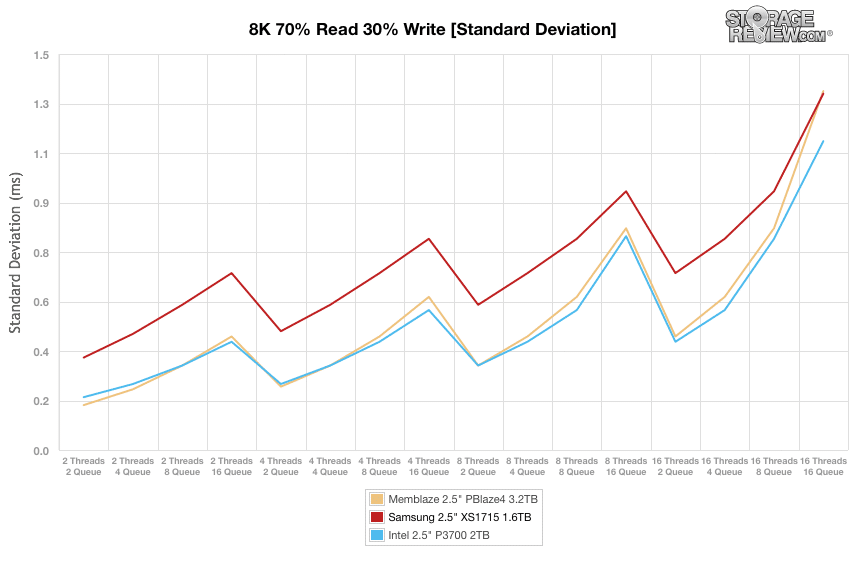
Conclusion
Hitting the market approximately a year ago, the Samsung XS1715 is touted as one of the industry’s first NVMe solid-state drive, capable of boasting performance that wasn't seen before in high-speed server storage. This was not very surprising, as Samsung has been a front runner in solid-state industry in both the consumer and enterprise areas for quite some time now. Though we already looked at the Samsung drive briefly during our Dell PowerEdge R920 review, we decided to see how the 1.6TB model stacked up against newer NVMe drives a year after its release. Available in capacities of 400GB, 800GB and 1.6TB, the Samsung XS1715 features full data path and power loss protection through its equipped tantalum capacitors and provides a UBER rating of 1 in 1017 with a two million hour MTBF.
Looking at performance certainly showed us that the Samsung XS1715 had a bit of trouble keeping up with the newer NVMe drives, the Memblaze PBlaze4 3.2TB and Intel P3700 2TB SSDs, in many of our tested workloads. In our SQL Server test, the Samsung drive trailed the Intel drive by under 0.1 TPS for top spot while boasting an average speed of 3,157. In addition, average latency of the Samsung XS1715 during the same showed 7.0ms (as well as an average of 7.0ms), placing it at the very top of the leaderboard. In our Sysbench tests, we saw TPS reach 3,463.6, an average latency of 36.96ms, and a worst case (99th percentile) aggregate result of 73.03ms, all of which were last among the comparables. During our Synthetic benchmarks, the Samsung XS1715 gave us a 4k throughput of 420,544 IOPS read and 114,444 IOPS write, an average latency of 1.61ms read and 2.23ms write, and leading max latency/standard deviation performance of 5.8ms read and 0.08ms read. Things slowed down a bit in our 8k 70/30 workload, as Samsung drive ranked mostly at the bottom of pack.
Pros
- The first 2.5" NVMe SSD to be released
- Programmable architecture within the controller
- Consistent latency under load
Cons
- Slower Sysbench performance
Bottom Line
Even after a year since its release, the Samsung XS1715 is an NVMe SSD that performs well and holds its own versus models that were just recently released.




 Amazon
Amazon